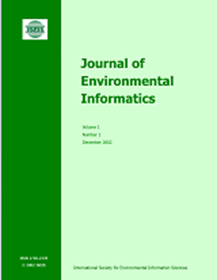复杂地形空气污染扩散的混合风预报
IF 5.4
1区 环境科学与生态学
Q1 ENVIRONMENTAL SCIENCES
引用次数: 0
摘要
在核电站发生意外排放事件的情况下,当有效的大气扩散模型结果可用时,可以更有效地保护当地人口。大气弥散模式使用当地气象变量作为输入。在预测未来的大气弥散时,需要对当地气象变量进行预报。大气弥散模拟中最重要的变量是风,准确预测地面风对数值天气预报模式提出了挑战。因此,我们开发了混合模型,用于预测地形复杂、平均风弱且波动的单一地点的当地地面风。风速和风向建模为西风、东风和南风分量。每个模型由数值天气预报模型和高斯过程统计模型组成,高斯过程统计模型使用数值天气预报作为其部分输入,并根据历史数据进行训练以预测输出组件。研究最先进的高斯过程模型是外生输入高斯过程非线性自回归模型(GPNARX)型。除了数值天气预报外,它们还使用当地气象变量,包括输出变量作为输入。因此,基于大尺度信息和系统基本知识的数值天气预报结果可由更能反映当地地形和土地利用影响的当地测量结果补充。通过预测和仿真对模型进行了验证。较先进模式预测的风分量比原始或后处理的数值天气预报结果更准确。例如,如果使用所有即时可用的信息,提前1.5小时预测2D风矢量的模型的NRMSE为0.214。这优于NRMSE为0.188的持久性模型和NRMSE为0.164的后处理NWP模型。这表明混合模式为短期和中期大气弥散预报提供了最好的天气信息。虽然该方法是由核排放源驱动的,但它也可以应用于其他污染。本文章由计算机程序翻译,如有差异,请以英文原文为准。
Hybrid Forecasting of Wind for Air Pollution Dispersion over Complex Terrain
In case of an unplanned emission event from a nuclear power plant, the local population can be protected more efficiently when valid atmospheric dispersion model results are available. Atmospheric dispersion models use local meteorological variables as inputs. When atmospheric dispersion in the future is being predicted, a forecast of the local meteorological variables is needed. The most important variable in atmospheric dispersion modelling is wind, and accurately predicting ground level winds presents a challenge to numerical weather prediction models. We therefore develop hybrid models for forecasting local ground level wind at a single location where the terrain is complex and the average wind is weak and fluctuating. Wind speed and direction are modelled as west-east and south-north wind components. Each model is composed of a numerical weather prediction model and a Gaussian process statistical model that uses numerical weather predictions as some of its inputs and is trained on historical data to predict the output component. The most advanced Gaussian process models studied are of Gaussian process nonlinear autoregressive model with exogenous input (GPNARX) type. In addition to numerical weather predictions, they also use local meteorological variables, including the output variable, as their inputs. Numerical weather prediction results based on large scale information and fundamental knowledge of the system are thus supplemented by local measurements that better reflect the effects of local topography and land use. The models are tested by prediction and simulation. The wind components predicted by more advanced models are more accurate than raw or post-processed numerical weather prediction results. As an example, a model predicting 2D wind vector 1.5 h in advance achieves a NRMSE of 0.214 if it uses all the immediately available information. This is better than both the persistence model with NRMSE of 0.188 and post-processed NWP with NRMSE of 0.164. This demonstrates that hybrid modelling provides the best weather information for short-term and medium-term atmospheric dispersion forecasting. While the method is motivated by nuclear emission sources, it could also be applied to other pollution.
求助全文
通过发布文献求助,成功后即可免费获取论文全文。
去求助
来源期刊

Journal of Environmental Informatics
ENVIRONMENTAL SCIENCES-
CiteScore
12.40
自引率
2.90%
发文量
7
审稿时长
24 months
期刊介绍:
Journal of Environmental Informatics (JEI) is an international, peer-reviewed, and interdisciplinary publication designed to foster research innovation and discovery on basic science and information technology for addressing various environmental problems. The journal aims to motivate and enhance the integration of science and technology to help develop sustainable solutions that are consensus-oriented, risk-informed, scientifically-based and cost-effective. JEI serves researchers, educators and practitioners who are interested in theoretical and/or applied aspects of environmental science, regardless of disciplinary boundaries. The topics addressed by the journal include:
- Planning of energy, environmental and ecological management systems
- Simulation, optimization and Environmental decision support
- Environmental geomatics - GIS, RS and other spatial information technologies
- Informatics for environmental chemistry and biochemistry
- Environmental applications of functional materials
- Environmental phenomena at atomic, molecular and macromolecular scales
- Modeling of chemical, biological and environmental processes
- Modeling of biotechnological systems for enhanced pollution mitigation
- Computer graphics and visualization for environmental decision support
- Artificial intelligence and expert systems for environmental applications
- Environmental statistics and risk analysis
- Climate modeling, downscaling, impact assessment, and adaptation planning
- Other areas of environmental systems science and information technology.
 求助内容:
求助内容: 应助结果提醒方式:
应助结果提醒方式:


